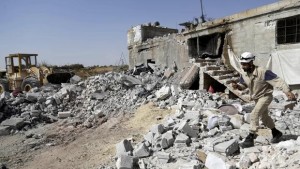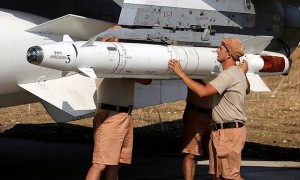
of a damaged building next to a site hit by what activists
said were airstrikes carried out by the Russian airforce. Photo credit: CBS News
As many people have already heard, Russia has joined the war in Syria, where Russian warplanes have carried out airstrikes on opponents of President Bashar al-Assad. This recent addition to the four year civil war in Syria has added new elements, which continue to further the suffering for many civilians.
Russia claimed that they are targeting the Islamic State (IS) and “other terrorists” when on 30 September, Russia’s parliament approved a request by President Vladimir Putin to launch airstrikes in Syria. This is the country’s first intervention in the Middle East in decades, which leads one to ponder what their real intention behind their involvement in Syria is.
Presidents Putin and Assad have been long-standing political allies, and most are aware of this relationship; however, Mr. Putin said Russia was acting “preventatively, to fight and destroy militants and terrorists on the territories that they already occupy, not wait for them to come to our house.” A poor argument given the applicability of that argument to many other war-torn countries, which have yet to see a Russian intervention.
Not to mention the context of the relationship between Putin and Assad, which includes historical ties between the two countries, and Syria containing the last Russian naval base in the Middle East. Russia has also blocked numerous resolutions critical of Assad at the UN Security council, and supplied weapons to the Syrian military—this current Russian intervention only continues and further solidifies the relationship between the two as political allies.
The Russian Defence Ministry originally said the first strikes targeted only the jihadist group IS, which controls large parts of Syria and is fighting both government and rebel forces. The next day, Russian Foreign Minister Sergei Lavrov clarified that the air campaign was targeting “all terrorists” in Syria, and not just IS. His ministry said a report by the Syrian Civil Defence rescue organization of 33 civilian deaths on the first day of the airstrikes was “false.”
Even more interesting is the fact that the US and allies have noted that the strikes are occurring in places where IS has little to no presence. Alternatively, the strikes are aimed at rebels backed by Gulf Arab and Western states who are advancing on Latakia province, which is the core of Assad’s Alawite sect. The political dimensions behind Russia’s intervention shine through, providing much more plausible reasoning, rather than fear of terrorists attacking Russia.

warplane in a Syrian airbase outside Latakia.
Photo credit: The Guardian
The reaction from Syria seems to be divided, where some have hope for Russia to end this agonizing situation, and others fear their situation has just gotten worse. Opposition activists have expressed alarm over the effect this Russian intervention will have on civilians. Khoodair Khusheif, an activist in northern Homs province, stated to the New York Times, “If these raids continue this way, Russia will kill a larger number of civilians than Bashar did in four years.” The reality is that Russia’s intervention arises out of selfish reasoning, and the Syrian civilians are secondary thoughts, at best, to the existent political battles.
The US are all but impressed with this new addition to the war in Syria. US Defence Secretary Ashton Carter said Russia was “pouring gasoline on a fire.” He went on to warn that Russia “risks escalating the civil war in Syria—and with it, the very extremism and instability that Moscow claims to be concerned about.” The US does not seem to be accepting of the Russian argument indicating their only intent is to fight terrorism, which is interesting given the US not too long ago was utilizing the same arguments for their own Middle East interventions.
However, the most important aspect of this situation is the high human costs—more than 250,000 Syrians have been killed and a million injured. At least eleven million others have been forced from their homes, four million have fled abroad, and we continue to hear their horror stories as they embark on the journey of their lives. It is a sad reality that these lives are not the priority, and instead protection of political alliances reigns supreme. The Russian intervention in the Syrian war not only illustrates this point, but also serves to demonstrate that the instability within Syria will most likely continue.
